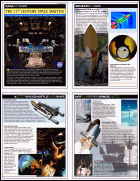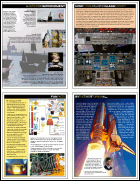|
This example shows how to draw one PDF into another. It takes a
PDF document and creates a 'four-up' summary document by drawing
four pages on each page of the new document.
First we create an ABCpdf Doc object and read in our source
document.
[C#]
Doc theSrc = new
Doc();
theSrc.Read(Server.MapPath("../Rez/spaceshuttle.pdf"));
int
theCount = theSrc.PageCount;
[Visual Basic]
Dim theSrc As Doc =
New Doc()
theSrc.Read(Server.MapPath("../Rez/spaceshuttle.pdf"))
Dim
theCount As Integer = theSrc.PageCount
Next we create a destination Doc object and set the MediaBox so that the page
size will match that of the source document. We change the rect so
that it occupies a quarter of the page with room to accomodate a
small margin.
[C#]
Doc theDst = new
Doc();
theDst.MediaBox.String =
theSrc.MediaBox.String;
theDst.Rect.String =
theDst.MediaBox.String;
theDst.Rect.Magnify(0.5,
0.5);
theDst.Rect.Inset(10, 10);
double theX, theY;
theX =
theDst.MediaBox.Width / 2;
theY = theDst.MediaBox.Height /
2;
[Visual
Basic]
Dim theDst As Doc = New Doc()
theDst.MediaBox.String =
theSrc.MediaBox.String
theDst.Rect.String =
theDst.MediaBox.String
theDst.Rect.Magnify(0.5,
0.5)
theDst.Rect.Inset(10, 10)
Dim theX As Double,theY As
Double
theX = theDst.MediaBox.Width / 2
theY =
theDst.MediaBox.Height / 2
We go through every page in the source document drawing a framed
copy of each page at a different position on our four-up document.
Every fourth page we add a new page into our destination
document.
[C#]
for (int i = 1; i <=
theCount; i++) {
switch (i % 4)
{
case
1:
theDst.Page =
theDst.AddPage();
theDst.Rect.Position(10,
theY +
10);
break;
case
2:
theDst.Rect.Position(theX
+ 10, theY + 10);
break;
case
3:
theDst.Rect.Position(10,
10);
break;
case
0:
theDst.Rect.Position(theX
+ 10, 10);
break;
}
theDst.AddImageDoc(theSrc, i,
null);
theDst.FrameRect();
}
[Visual Basic]
For i As Integer = 1
To theCount
Select Case i Mod
4
Case
1
theDst.Page =
theDst.AddPage()
theDst.Rect.Position(10,
theY + 10)
Case
2
theDst.Rect.Position(theX +
10, theY + 10)
Case
3
theDst.Rect.Position(10,
10)
Case
0
theDst.Rect.Position(theX +
10, 10)
End
Select
theDst.AddImageDoc(theSrc, i,
Nothing)
theDst.FrameRect()
Next
Finally we save.
[C#]
theDst.Save(Server.MapPath("fourup.pdf"));
//
finished
[Visual
Basic]
theDst.Save(Server.MapPath("fourup.pdf"))
'
finished
We get the following output.

fourup.pdf - [Page 1] |

fourup.pdf - [Page 2] |
|

 Syntax
Syntax



 Syntax
Syntax

